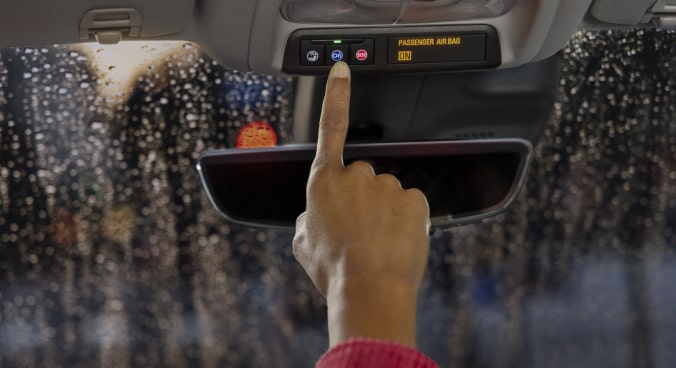Emergencies can happen in a split second. And they require you to act just as quickly. Every emergency — a crash, a breakdown or an act of nature — calls for a different response.
If you have OnStar, just push your red Emergency button and a specially trained Advisor can use GPS technology to pinpoint your location, dispatch whatever help you need and offer critical assistance until help arrives. In a crash, an Advisor is automatically connected into your vehicle to offer help,
During an act of nature, such as a hurricane or tornado, an Advisor can offer emergency services, evacuation routes and other resources. Or if stranded, push the blue OnStar button and an Advisor can get you Roadside Assistance.
We walk you through various steps for specific road emergencies. But first, a few general tips:
- If you don’t have OnStar, call 911.
- Turn on your hazard lights.
- If your vehicle is on the side of the road and it’s safe to get out, tie a cloth on the antenna or, preferably, place emergency reflective triangles around the car.
Water over the road
As few as two feet of rushing water can sweep away a vehicle. Rather than driving through flooded areas, try to find a different route.
What to do:
- Drive at slower speeds to avoid a “hydroplaning” effect. Most tires lose traction around 35 mph.
- If you lose traction, ease off the gas and keep the steering wheel straight.
- Don’t try to stop or turn until your tires are gripping the road again.
- If you have to turn, do it slowly.
Plunging into deep water
A submerged vehicle can fill with water in seconds. Water has incredible force, so it’s important to know how to break free from its grasp.
What to do:
- If you have OnStar, push the red Emergency button as soon as possible to connect with an Advisor who can send help. Unlatch your safety belt and anyone else’s in a car seat or booster seat.
- Water rushes in with thousands of pounds of pressure. You can try opening the door but it may be difficult until the water pressure inside and outside the vehicle is equal.
- If you cannot open a door, try opening a window (or sunroof). This will be easiest to do when the water is about halfway up the glass.
- If you can’t open a door or window, break the glass with a sharp tool or pocketknife. It’s best to keep a “spring punch” tool in your door pocket. Spring punches should be available at auto parts or hardware stores.
- If you can’t get out of the vehicle, have everyone stand on their seats to reach air pockets above.
A vehicle crash
A crash can be disorienting, making it valuable to have a game plan ahead of time. The goal here is to keep everyone safe until help arrives.
What to do:
- If possible, move your vehicle out of the flow of traffic.
- Turn off your vehicle.
- Turn on your hazard flashers.
- If oncoming traffic or a dangerous neighborhood makes it unsafe to leave the car, stay safely buckled.
- If you have OnStar, most crashes can trigger an Automatic Crash Response. An OnStar Advisor is immediately connected into your vehicle to help, and has tools to help predict the likelihood of serious injuries.
- If you don’t have OnStar, call 911. Describe your location as specifically as you can.
- Check passengers for injuries, such as breathing and bleeding problems. Apply direct pressure to a bleeding injury, ideally with a cloth to prevent infection.
- Don’t move a badly injured passenger unless your vehicle is burning or in danger of being hit by another vehicle. Don’t give injured people liquids.
- If you’re outside the vehicle, stay away from downed power lines. Avoid smoking because there may be a fuel spill.
- If safe, capture the scene by taking photos or sketching the position and direction of the cars.
- Get the name, phone number, driver’s license number, insurance company, license plate and VIN of the other driver(s)/vehicles, and contact information for any witnesses.
- Call your insurance company to file a report.
A car fire
The goal is to get to a safe place and let emergency personnel do the rest.
What to do:
- Drive onto a breakdown lane as quickly and safely as possible.
- Once you’re in a safe location, get everyone out of the vehicle and away from the fire. Warn bystanders to stay away as well.
- Don’t try to put out the fire. Emergency responders are better equipped to handle the situation.
A tire blowout
Road debris or underinflated tires can result in a blowout without warning and make your vehicle difficult to handle. A few simple steps can help you keep your vehicle under control.
What to do:
- Hold onto the steering wheel firmly to keep the vehicle straight.
- Don’t slam on the brakes or jerk the steering wheel. Instead, take your foot off the gas to gradually slow the vehicle.
- As the vehicle slows, steer your vehicle onto the shoulder. Riding on a bare rim can cause significant damage to the wheel.
- Change the tire if you know how and you’re in a safe area. Keep in mind that spare tires are for short-term use. You’ll need to replace your tire as soon as possible.
- If you don’t know how to change your tire, or you’re in an unsafe location, push your blue OnStar button and an Advisor can send Roadside Assistance.
* If you don’t have OnStar, use your mobile device to call for roadside service.
Failing brakes
It’s rare that your brakes will give out, but being prepared can go a long way to minimizing damage.
What to do:
- Try pumping the brakes to build up enough pressure to stop your vehicle.
- If that doesn’t work, shift into a lower gear (M, L1 or 2).
- Slowly apply the emergency brake. Note: Rear wheels can lock if you do this too quickly. Be ready to release the brake if the vehicle starts to skid.
- Steer to the side of the road. Look for something to help slow the vehicle — a fence, a guardrail — and swipe the vehicle against it.
- Turn off the engine. Do not try to drive the vehicle.
Spinning or sliding sideways
You may encounter wet, icy or oily roads without warning. Recommended steps may be a bit counterintuitive, so it’s worth practicing these moves.
What to do:
- Accelerating and slamming on the brakes can cause more spinning or sliding. Instead, slowly release the gas pedal until you regain control of the vehicle.
- Gripping the steering wheel too tightly can make it more difficult to correct the problem. A lighter hand works better.
- Steer in the direction of the spin. For example, if your rear tires are sliding to the right, turn the wheel to the right.
Vehicle rollover
If you run off the road or you’re involved in a collision, your car may roll over. If your safety belt is buckled and you can stay calm, you’ll be in a better position to handle this emergency.
What to do:
- Keep your thumbs on the outside of the steering wheel to prevent injury on impact.
- When the vehicle comes to a stop, turn off the ignition to help prevent a fire.
- If you detect gas, get everyone out of the vehicle immediately.
- If the vehicle lands upside down:
- Open the window.
- Press your left arm into the roof.
- Bend your knees and place your legs on either side of the steering wheel.
- Push with your legs until your body is firmly pressed against the seat.
- Bend your head, tuck in your chin and release your safety belt with your free hand.
- Slide out the window.
A lightning storm
Your vehicle is a safer place during an electrical storm than under a tree or in a partially open shelter.
What to do:
- Pull over.
- Stay in your vehicle unless you can easily access nearby shelter.
- While in the vehicle, keep your hands in your lap and away from metal parts — like door handles or the radio. Lightning can move through electrical and metal components and cause injury.
- Wait for the storm to pass before driving.
Locked in a hot car
Within a few minutes, a vehicle’s interior temperature can rise 40 degrees higher than the outside temperature. The elderly and children are especially prone to overheating. A young child’s body can heat up five times faster than an adult’s, which can result in heatstroke.
What to do:
- If you see a child alone in a vehicle, call 911 immediately or, if you have an OnStar-equipped vehicle, push your red Emergency button. Emergency responders can help rescue the child.
Locked in a trunk
The lack of ventilation and the possibility of heatstroke can make the trunk a dangerous space. That’s why it’s important to limit access to the trunk by keeping fold-down seats up and locking the car doors and trunk.
What to do:
- Pull or push the glow-in-the-dark interior emergency trunk release, available in cars made after September 1, 2001.
- If someone is locked in a trunk, get them out as quickly as possible.
- If the weather is warm, call 911 for emergency assistance on how to check for heatstroke.
Consider reviewing this list from time to time. It will go a long way toward preparing you for situations that demand split-second decisions.
Remember, if you have OnStar, Advisors can help you through a broad range of emergencies from opening locked vehicle doors to sending for assistance when someone is unable to report their own crash, but some emergencies require you to take the initial steps.
Do you have the right stuff? Find out if you have the necessary emergency supplies in your vehicle.





















